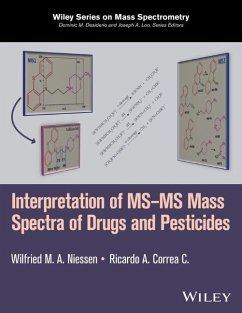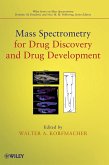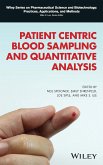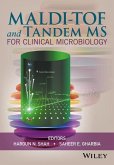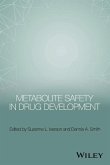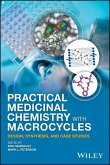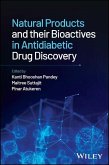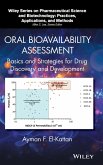Wilfried M. A. Niessen, Ricardo A. Correa C.
Interpretation of Ms-MS Mass Spectra of Drugs and Pesticides
Wilfried M. A. Niessen, Ricardo A. Correa C.
Interpretation of Ms-MS Mass Spectra of Drugs and Pesticides
- Gebundenes Buch
- Merkliste
- Auf die Merkliste
- Bewerten Bewerten
- Teilen
- Produkt teilen
- Produkterinnerung
- Produkterinnerung
Provides comprehensive coverage of the interpretation of LC-MS-MS mass spectra of 1300 drugs and pesticides _ Provides a general discussion on the fragmentation of even-electron ions (protonated and deprotonated molecules) in both positive-ion and negative-ion modes _ This is the reference book for the interpretation of MS-MS mass spectra of small organic molecules _ Covers related therapeutic classes of compounds such as drugs for cardiovascular diseases, psychotropic compounds, drugs of abuse and designer drugs, antimicrobials, among many others _ Covers general fragmentation rule as well as…mehr
Andere Kunden interessierten sich auch für
![Mass Spectrometry for Drug Discovery and Drug Development Mass Spectrometry for Drug Discovery and Drug Development]() Mass Spectrometry for Drug Discovery and Drug Development154,99 €
Mass Spectrometry for Drug Discovery and Drug Development154,99 €![Patient Centric Blood Sampling and Quantitative Analysis Patient Centric Blood Sampling and Quantitative Analysis]() Patient Centric Blood Sampling and Quantitative Analysis184,99 €
Patient Centric Blood Sampling and Quantitative Analysis184,99 €![Maldi-Tof and Tandem MS for Clinical Microbiology Maldi-Tof and Tandem MS for Clinical Microbiology]() Maldi-Tof and Tandem MS for Clinical Microbiology188,99 €
Maldi-Tof and Tandem MS for Clinical Microbiology188,99 €![Metabolite Safety in Drug Development Metabolite Safety in Drug Development]() Metabolite Safety in Drug Development229,99 €
Metabolite Safety in Drug Development229,99 €![Practical Medicinal Chemistry with Macrocycles Practical Medicinal Chemistry with Macrocycles]() Practical Medicinal Chemistry with Macrocycles251,99 €
Practical Medicinal Chemistry with Macrocycles251,99 €![Natural Products and Their Bioactives in Antidiabetic Drug Discovery Natural Products and Their Bioactives in Antidiabetic Drug Discovery]() Natural Products and Their Bioactives in Antidiabetic Drug Discovery205,99 €
Natural Products and Their Bioactives in Antidiabetic Drug Discovery205,99 €![Oral Bioavailability Assessment Oral Bioavailability Assessment]() Ayman F. El-KattanOral Bioavailability Assessment220,99 €
Ayman F. El-KattanOral Bioavailability Assessment220,99 €-
-
-
Provides comprehensive coverage of the interpretation of LC-MS-MS mass spectra of 1300 drugs and pesticides
_ Provides a general discussion on the fragmentation of even-electron ions (protonated and deprotonated molecules) in both positive-ion and negative-ion modes
_ This is the reference book for the interpretation of MS-MS mass spectra of small organic molecules
_ Covers related therapeutic classes of compounds such as drugs for cardiovascular diseases, psychotropic compounds, drugs of abuse and designer drugs, antimicrobials, among many others
_ Covers general fragmentation rule as well as specific fragmentation pathways for many chemical functional groups
_ Gives an introduction to MS technology, mass spectral terminology, information contained in mass spectra, and to the identification strategies used for different types of unknowns
Hinweis: Dieser Artikel kann nur an eine deutsche Lieferadresse ausgeliefert werden.
_ Provides a general discussion on the fragmentation of even-electron ions (protonated and deprotonated molecules) in both positive-ion and negative-ion modes
_ This is the reference book for the interpretation of MS-MS mass spectra of small organic molecules
_ Covers related therapeutic classes of compounds such as drugs for cardiovascular diseases, psychotropic compounds, drugs of abuse and designer drugs, antimicrobials, among many others
_ Covers general fragmentation rule as well as specific fragmentation pathways for many chemical functional groups
_ Gives an introduction to MS technology, mass spectral terminology, information contained in mass spectra, and to the identification strategies used for different types of unknowns
Hinweis: Dieser Artikel kann nur an eine deutsche Lieferadresse ausgeliefert werden.
Produktdetails
- Produktdetails
- Wiley-Interscience Series on Mass Spectrometry
- Verlag: Wiley / Wiley & Sons
- Artikelnr. des Verlages: 1W118500180
- 1. Auflage
- Seitenzahl: 416
- Erscheinungstermin: 30. Januar 2017
- Englisch
- Abmessung: 287mm x 225mm x 30mm
- Gewicht: 1217g
- ISBN-13: 9781118500187
- ISBN-10: 1118500180
- Artikelnr.: 42055691
- Herstellerkennzeichnung
- Libri GmbH
- Europaallee 1
- 36244 Bad Hersfeld
- gpsr@libri.de
- Wiley-Interscience Series on Mass Spectrometry
- Verlag: Wiley / Wiley & Sons
- Artikelnr. des Verlages: 1W118500180
- 1. Auflage
- Seitenzahl: 416
- Erscheinungstermin: 30. Januar 2017
- Englisch
- Abmessung: 287mm x 225mm x 30mm
- Gewicht: 1217g
- ISBN-13: 9781118500187
- ISBN-10: 1118500180
- Artikelnr.: 42055691
- Herstellerkennzeichnung
- Libri GmbH
- Europaallee 1
- 36244 Bad Hersfeld
- gpsr@libri.de
Wilfried M A Niessen is an analytical chemist with 34 years of experience as a researcher and project manager in the field of principles, instrumentation and applications of liquid chromatography-mass spectrometry. As a consultant for hyphen MassSpec, he provided over 400 courses in more than 15 countries, as well as many consultancy projects. He was extraordinary professor bioanalytical mass spectrometry at VU University Amsterdam. He is the (co)author of more than 210 publications; over 40 book chapters; 6 books and guest-editor for 6 special volumes on mass spectrometry topics published by the Journal of Chromatography A. Ricardo A Correa C is an organic chemist who has been involved with mass spectrometry for 25 years. He runs Trans-Laboratory, a chemical analysis service provider, offering course cycles around Europe on analytical chemistry where GC-MS and LC-MS play a central role. He has developed applications which have been presented in scientific meetings in Belgium and The Netherlands, as well as coordinated the set-up of analytical chemistry laboratories overseas. He is the co-author of publications for reputed chemistry journals such as the Journal of the American Chemical Society, the Journal of Organic chemistry, the Journal of Chromatography A .
Preface xi
Abbreviations xiii
1 Introduction to LC-MS Technology 1
1.1 Introduction 2
1.2 Analyte Ionization: Ion Sources 3
1.2.1 Electron Ionization 3
1.2.2 Chemical Ionization 7
1.2.3 Atmospheric-Pressure Ionization 13
1.2.4 Electrospray Ionization 16
1.2.5 Atmospheric-Pressure Chemical Ionization and Photoionization 20
1.2.6 Other Ionization Techniques 26
1.3 Mass Spectrometer Building Blocks 28
1.3.1 Introduction 28
1.3.2 Quadrupole Mass Analyzer 32
1.3.3 Ion-Trap Mass Analyzer 33
1.3.4 Time-of-Flight Mass Analyzer 34
1.3.5 Orbitrap Mass Analyzer 35
1.3.6 Other Mass Analyzers 36
1.4 Tandem Mass Spectrometry 37
1.4.1 Introduction 37
1.4.2 Tandem Quadrupole Instruments 39
1.4.3 Ion-Trap Instruments 40
1.4.4 Quadrupole-Linear Ion-Trap Hybrid Instruments 41
1.4.5 Quadrupole-Time-of-Flight Hybrid Instruments 41
1.4.6 Orbitrap Hybrid Instruments for MS-MS and MSn 41
1.4.7 Other Instruments for MS-MS and MSn 42
1.4.8 MS-MS and MSn in the Analysis of Drugs and Pesticides 43
1.5 Data Acquisition 43
1.5.1 Introduction 43
1.5.2 Selected-Ion and Selected-Reaction Monitoring 44
1.5.3 Structure-Specific Screening: Precursor-Ion and Neutral-Loss Analysis 44
1.5.4 Data-Dependent Acquisition 45
1.5.5 Data-Independent Acquisition 45
1.6 Selected Literature on Mass Spectrometry 45
2 Interpretation of Mass Spectra 55
2.1 Mass Spectrometry: A Nuclear Affair 55
2.2 Isomers, Isotones, Isobars, Isotopes 56
2.3 Masses in MS 58
2.4 Isotopes and Structure Elucidation 60
2.5 Nitrogen Rule, Ring Double-Bond Equivalent, and Hydrogen Rule 61
2.6 Resolving Power, Resolution, Accuracy 63
2.7 Calculating Elemental Composition from Accurate m/z 66
2.8 Protonated and Deprotonated Molecules and Adduct Ions 67
3 Fragmentation of Even-Electron Ions 71
3.1 Introduction 72
3.2 Analyte Ionization Revisited 73
3.3 Fragmentation of Odd-electron Ions 74
3.4 High-energy Collisions of Protonated Molecules 76
3.4.1 General Aspects 77
3.4.2 Selected Examples 79
3.5 Fragmentation of Protonated Molecules 81
3.5.1 Singly-Charged Peptides 82
3.5.2 Protonated Small Molecules: Complementary Fragment Ions 83
3.5.3 Fragmentation of Peptides Revisited 86
3.5.4 Direct-Cleavage Reactions 89
3.5.5 Consecutive Small-Molecule Losses 89
3.5.6 Other Fragmentation Reactions 89
3.5.7 Loss of Radicals from Even-Electron Ions 91
3.5.8 Skeletal Rearrangements in Protonated Molecules 92
3.6 Characteristic Positive-ion Fragmentation of Functional Groups 94
3.6.1 Cleavages of C-C Bonds 94
3.6.2 Alcohols and Ethers 95
3.6.3 Aldehydes and Ketones 96
3.6.4 Carboxylic Acids and Esters 96
3.6.5 Amines and Quaternary Ammonium Compounds 98
3.6.6 Amides, Sulfonyl Ureas, and Carbamates 99
3.6.7 Compounds containing Phosphorus or Sulfur 101
3.6.8 Miscellaneous Compound Classes 101
3.7 Fragmentation of Deprotonated Molecules 102
3.7.1 High-Energy CID with NICI-Generated Deprotonated Molecules 102
3.7.2 General Aspects 102
3.7.3 Alcohols and Ethers 102
3.7.4 Carboxylic Acid and Esters 103
3.7.5 Amines 104
3.7.6 Amides and Ureas 104
3.7.7 Sulfonamides
Abbreviations xiii
1 Introduction to LC-MS Technology 1
1.1 Introduction 2
1.2 Analyte Ionization: Ion Sources 3
1.2.1 Electron Ionization 3
1.2.2 Chemical Ionization 7
1.2.3 Atmospheric-Pressure Ionization 13
1.2.4 Electrospray Ionization 16
1.2.5 Atmospheric-Pressure Chemical Ionization and Photoionization 20
1.2.6 Other Ionization Techniques 26
1.3 Mass Spectrometer Building Blocks 28
1.3.1 Introduction 28
1.3.2 Quadrupole Mass Analyzer 32
1.3.3 Ion-Trap Mass Analyzer 33
1.3.4 Time-of-Flight Mass Analyzer 34
1.3.5 Orbitrap Mass Analyzer 35
1.3.6 Other Mass Analyzers 36
1.4 Tandem Mass Spectrometry 37
1.4.1 Introduction 37
1.4.2 Tandem Quadrupole Instruments 39
1.4.3 Ion-Trap Instruments 40
1.4.4 Quadrupole-Linear Ion-Trap Hybrid Instruments 41
1.4.5 Quadrupole-Time-of-Flight Hybrid Instruments 41
1.4.6 Orbitrap Hybrid Instruments for MS-MS and MSn 41
1.4.7 Other Instruments for MS-MS and MSn 42
1.4.8 MS-MS and MSn in the Analysis of Drugs and Pesticides 43
1.5 Data Acquisition 43
1.5.1 Introduction 43
1.5.2 Selected-Ion and Selected-Reaction Monitoring 44
1.5.3 Structure-Specific Screening: Precursor-Ion and Neutral-Loss Analysis 44
1.5.4 Data-Dependent Acquisition 45
1.5.5 Data-Independent Acquisition 45
1.6 Selected Literature on Mass Spectrometry 45
2 Interpretation of Mass Spectra 55
2.1 Mass Spectrometry: A Nuclear Affair 55
2.2 Isomers, Isotones, Isobars, Isotopes 56
2.3 Masses in MS 58
2.4 Isotopes and Structure Elucidation 60
2.5 Nitrogen Rule, Ring Double-Bond Equivalent, and Hydrogen Rule 61
2.6 Resolving Power, Resolution, Accuracy 63
2.7 Calculating Elemental Composition from Accurate m/z 66
2.8 Protonated and Deprotonated Molecules and Adduct Ions 67
3 Fragmentation of Even-Electron Ions 71
3.1 Introduction 72
3.2 Analyte Ionization Revisited 73
3.3 Fragmentation of Odd-electron Ions 74
3.4 High-energy Collisions of Protonated Molecules 76
3.4.1 General Aspects 77
3.4.2 Selected Examples 79
3.5 Fragmentation of Protonated Molecules 81
3.5.1 Singly-Charged Peptides 82
3.5.2 Protonated Small Molecules: Complementary Fragment Ions 83
3.5.3 Fragmentation of Peptides Revisited 86
3.5.4 Direct-Cleavage Reactions 89
3.5.5 Consecutive Small-Molecule Losses 89
3.5.6 Other Fragmentation Reactions 89
3.5.7 Loss of Radicals from Even-Electron Ions 91
3.5.8 Skeletal Rearrangements in Protonated Molecules 92
3.6 Characteristic Positive-ion Fragmentation of Functional Groups 94
3.6.1 Cleavages of C-C Bonds 94
3.6.2 Alcohols and Ethers 95
3.6.3 Aldehydes and Ketones 96
3.6.4 Carboxylic Acids and Esters 96
3.6.5 Amines and Quaternary Ammonium Compounds 98
3.6.6 Amides, Sulfonyl Ureas, and Carbamates 99
3.6.7 Compounds containing Phosphorus or Sulfur 101
3.6.8 Miscellaneous Compound Classes 101
3.7 Fragmentation of Deprotonated Molecules 102
3.7.1 High-Energy CID with NICI-Generated Deprotonated Molecules 102
3.7.2 General Aspects 102
3.7.3 Alcohols and Ethers 102
3.7.4 Carboxylic Acid and Esters 103
3.7.5 Amines 104
3.7.6 Amides and Ureas 104
3.7.7 Sulfonamides
Preface xi
Abbreviations xiii
1 Introduction to LC-MS Technology 1
1.1 Introduction 2
1.2 Analyte Ionization: Ion Sources 3
1.2.1 Electron Ionization 3
1.2.2 Chemical Ionization 7
1.2.3 Atmospheric-Pressure Ionization 13
1.2.4 Electrospray Ionization 16
1.2.5 Atmospheric-Pressure Chemical Ionization and Photoionization 20
1.2.6 Other Ionization Techniques 26
1.3 Mass Spectrometer Building Blocks 28
1.3.1 Introduction 28
1.3.2 Quadrupole Mass Analyzer 32
1.3.3 Ion-Trap Mass Analyzer 33
1.3.4 Time-of-Flight Mass Analyzer 34
1.3.5 Orbitrap Mass Analyzer 35
1.3.6 Other Mass Analyzers 36
1.4 Tandem Mass Spectrometry 37
1.4.1 Introduction 37
1.4.2 Tandem Quadrupole Instruments 39
1.4.3 Ion-Trap Instruments 40
1.4.4 Quadrupole-Linear Ion-Trap Hybrid Instruments 41
1.4.5 Quadrupole-Time-of-Flight Hybrid Instruments 41
1.4.6 Orbitrap Hybrid Instruments for MS-MS and MSn 41
1.4.7 Other Instruments for MS-MS and MSn 42
1.4.8 MS-MS and MSn in the Analysis of Drugs and Pesticides 43
1.5 Data Acquisition 43
1.5.1 Introduction 43
1.5.2 Selected-Ion and Selected-Reaction Monitoring 44
1.5.3 Structure-Specific Screening: Precursor-Ion and Neutral-Loss Analysis 44
1.5.4 Data-Dependent Acquisition 45
1.5.5 Data-Independent Acquisition 45
1.6 Selected Literature on Mass Spectrometry 45
2 Interpretation of Mass Spectra 55
2.1 Mass Spectrometry: A Nuclear Affair 55
2.2 Isomers, Isotones, Isobars, Isotopes 56
2.3 Masses in MS 58
2.4 Isotopes and Structure Elucidation 60
2.5 Nitrogen Rule, Ring Double-Bond Equivalent, and Hydrogen Rule 61
2.6 Resolving Power, Resolution, Accuracy 63
2.7 Calculating Elemental Composition from Accurate m/z 66
2.8 Protonated and Deprotonated Molecules and Adduct Ions 67
3 Fragmentation of Even-Electron Ions 71
3.1 Introduction 72
3.2 Analyte Ionization Revisited 73
3.3 Fragmentation of Odd-electron Ions 74
3.4 High-energy Collisions of Protonated Molecules 76
3.4.1 General Aspects 77
3.4.2 Selected Examples 79
3.5 Fragmentation of Protonated Molecules 81
3.5.1 Singly-Charged Peptides 82
3.5.2 Protonated Small Molecules: Complementary Fragment Ions 83
3.5.3 Fragmentation of Peptides Revisited 86
3.5.4 Direct-Cleavage Reactions 89
3.5.5 Consecutive Small-Molecule Losses 89
3.5.6 Other Fragmentation Reactions 89
3.5.7 Loss of Radicals from Even-Electron Ions 91
3.5.8 Skeletal Rearrangements in Protonated Molecules 92
3.6 Characteristic Positive-ion Fragmentation of Functional Groups 94
3.6.1 Cleavages of C-C Bonds 94
3.6.2 Alcohols and Ethers 95
3.6.3 Aldehydes and Ketones 96
3.6.4 Carboxylic Acids and Esters 96
3.6.5 Amines and Quaternary Ammonium Compounds 98
3.6.6 Amides, Sulfonyl Ureas, and Carbamates 99
3.6.7 Compounds containing Phosphorus or Sulfur 101
3.6.8 Miscellaneous Compound Classes 101
3.7 Fragmentation of Deprotonated Molecules 102
3.7.1 High-Energy CID with NICI-Generated Deprotonated Molecules 102
3.7.2 General Aspects 102
3.7.3 Alcohols and Ethers 102
3.7.4 Carboxylic Acid and Esters 103
3.7.5 Amines 104
3.7.6 Amides and Ureas 104
3.7.7 Sulfonamides
Abbreviations xiii
1 Introduction to LC-MS Technology 1
1.1 Introduction 2
1.2 Analyte Ionization: Ion Sources 3
1.2.1 Electron Ionization 3
1.2.2 Chemical Ionization 7
1.2.3 Atmospheric-Pressure Ionization 13
1.2.4 Electrospray Ionization 16
1.2.5 Atmospheric-Pressure Chemical Ionization and Photoionization 20
1.2.6 Other Ionization Techniques 26
1.3 Mass Spectrometer Building Blocks 28
1.3.1 Introduction 28
1.3.2 Quadrupole Mass Analyzer 32
1.3.3 Ion-Trap Mass Analyzer 33
1.3.4 Time-of-Flight Mass Analyzer 34
1.3.5 Orbitrap Mass Analyzer 35
1.3.6 Other Mass Analyzers 36
1.4 Tandem Mass Spectrometry 37
1.4.1 Introduction 37
1.4.2 Tandem Quadrupole Instruments 39
1.4.3 Ion-Trap Instruments 40
1.4.4 Quadrupole-Linear Ion-Trap Hybrid Instruments 41
1.4.5 Quadrupole-Time-of-Flight Hybrid Instruments 41
1.4.6 Orbitrap Hybrid Instruments for MS-MS and MSn 41
1.4.7 Other Instruments for MS-MS and MSn 42
1.4.8 MS-MS and MSn in the Analysis of Drugs and Pesticides 43
1.5 Data Acquisition 43
1.5.1 Introduction 43
1.5.2 Selected-Ion and Selected-Reaction Monitoring 44
1.5.3 Structure-Specific Screening: Precursor-Ion and Neutral-Loss Analysis 44
1.5.4 Data-Dependent Acquisition 45
1.5.5 Data-Independent Acquisition 45
1.6 Selected Literature on Mass Spectrometry 45
2 Interpretation of Mass Spectra 55
2.1 Mass Spectrometry: A Nuclear Affair 55
2.2 Isomers, Isotones, Isobars, Isotopes 56
2.3 Masses in MS 58
2.4 Isotopes and Structure Elucidation 60
2.5 Nitrogen Rule, Ring Double-Bond Equivalent, and Hydrogen Rule 61
2.6 Resolving Power, Resolution, Accuracy 63
2.7 Calculating Elemental Composition from Accurate m/z 66
2.8 Protonated and Deprotonated Molecules and Adduct Ions 67
3 Fragmentation of Even-Electron Ions 71
3.1 Introduction 72
3.2 Analyte Ionization Revisited 73
3.3 Fragmentation of Odd-electron Ions 74
3.4 High-energy Collisions of Protonated Molecules 76
3.4.1 General Aspects 77
3.4.2 Selected Examples 79
3.5 Fragmentation of Protonated Molecules 81
3.5.1 Singly-Charged Peptides 82
3.5.2 Protonated Small Molecules: Complementary Fragment Ions 83
3.5.3 Fragmentation of Peptides Revisited 86
3.5.4 Direct-Cleavage Reactions 89
3.5.5 Consecutive Small-Molecule Losses 89
3.5.6 Other Fragmentation Reactions 89
3.5.7 Loss of Radicals from Even-Electron Ions 91
3.5.8 Skeletal Rearrangements in Protonated Molecules 92
3.6 Characteristic Positive-ion Fragmentation of Functional Groups 94
3.6.1 Cleavages of C-C Bonds 94
3.6.2 Alcohols and Ethers 95
3.6.3 Aldehydes and Ketones 96
3.6.4 Carboxylic Acids and Esters 96
3.6.5 Amines and Quaternary Ammonium Compounds 98
3.6.6 Amides, Sulfonyl Ureas, and Carbamates 99
3.6.7 Compounds containing Phosphorus or Sulfur 101
3.6.8 Miscellaneous Compound Classes 101
3.7 Fragmentation of Deprotonated Molecules 102
3.7.1 High-Energy CID with NICI-Generated Deprotonated Molecules 102
3.7.2 General Aspects 102
3.7.3 Alcohols and Ethers 102
3.7.4 Carboxylic Acid and Esters 103
3.7.5 Amines 104
3.7.6 Amides and Ureas 104
3.7.7 Sulfonamides

